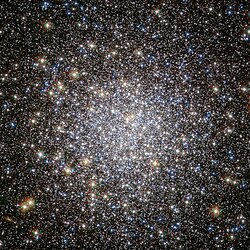Messier 5
| Messier 5 | |
|---|---|
| Apparent magnitude (V) | 5.6[4] |
| Apparent dimensions (V) | 23′.0 |
| Physical characteristics | |
| Mass | 8.57×105[5] M☉ |
| Radius | 80 ly |
| Metallicity | = –1.12 Gyr[6] |
| Other designations | NGC 5904, GCl 34[7] |
Messier 5 or M5 (also designated NGC 5904) is a globular cluster in the constellation Serpens. It was discovered by Gottfried Kirch in 1702.
Discovery and visibility
M5 is, under extremely good conditions, just visible to the naked eye as a faint "star" 0.37 of a degree (22' (
Notable features
Within M5, there are 105 known variable stars, 97 of them belonging to the RR Lyrae type.[11] RR Lyrae stars, sometimes referred to as "Cluster Variables", are somewhat similar to Cepheid type variables and as such can be used as a tool to measure distances in outer space since the relation between their luminosities and periods are well known. The brightest and most easily observed variable in M5 varies from magnitude 10.6 to 12.1 in a period of just under 26.5 days.[8]
The cluster contains two
A dwarf nova has also been observed in this cluster.[14]

See also
References
- Bibcode:1927BHarO.849...11S.
- ^ S2CID 119183070.
- S2CID 120965440.
- ^ "Messier 5". SEDS Messier Catalog. Retrieved 21 July 2024.
- S2CID 118649860.
- ^ S2CID 51825384.
- ^ "M 5". SIMBAD. Centre de données astronomiques de Strasbourg. Retrieved 2006-11-15.
- ^ Bibcode:1977JRASC..71..281C. Retrieved 1 March 2021.
- ^ "William Herschel's Observations of the Messier Objects". www.messier.seds.org. Students for the Exploration and Development of Space. Archived from the original on 24 June 2021. Retrieved 1 March 2021.
- doi:10.1086/118116.
- S2CID 118519067.
- S2CID 118743395.
- S2CID 59056210.
- doi:10.1086/340469.
External links
- SIMBAD: M5
- M5, SEDS Messier pages
- M5, Galactic Globular Clusters Database page
- Historic observations of M5
- Image of M5 by Waid Observatory
- Messier 5 on

![{\displaystyle {\begin{smallmatrix}\left[{\ce {Fe}}/{\ce {H}}\right]\end{smallmatrix}}}](https://wikimedia.org/api/rest_v1/media/math/render/svg/4c0821bd80891e071c08e7c7ee8e022baedf522c)
